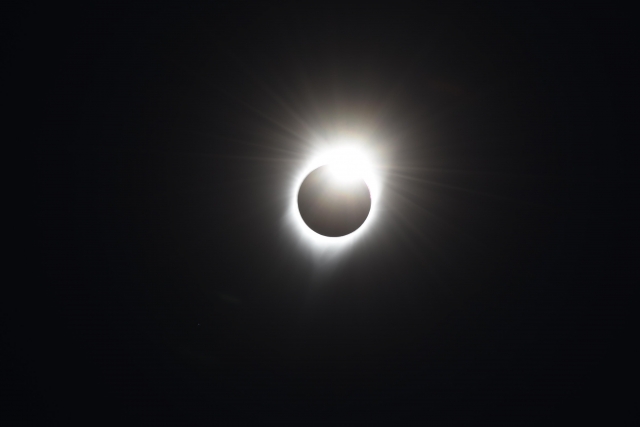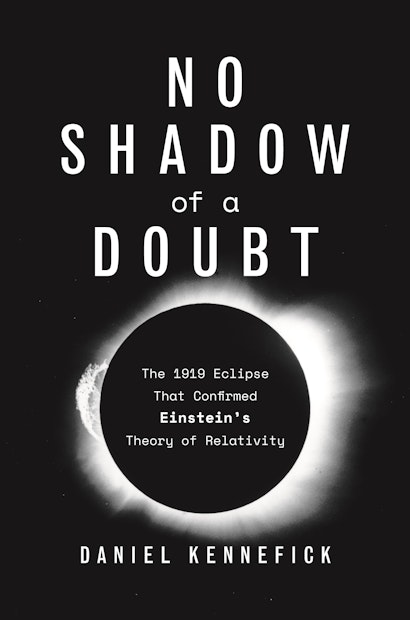In 1919, British scientists led extraordinary expeditions to Brazil and Africa to test Albert Einstein’s revolutionary new theory of general relativity in what became the century’s most celebrated scientific experiment. The result ushered in a new era and made Einstein a global celebrity by confirming his dramatic prediction that the path of light rays would be bent by gravity. Today, Einstein’s theory is scientific fact. Yet the effort to “weigh light” by measuring the gravitational deflection of starlight during the May 29, 1919, solar eclipse has become clouded by myth and skepticism. In No Shadow of a Doubt, Daniel Kennefick provides definitive answers by offering the most comprehensive and authoritative account of how expedition scientists overcame war, bad weather, and equipment problems to make the experiment a triumphant success.
What compelled you to write this book?
DK: The story of the 1919 eclipse is one of the most dramatic and significant in the history of science, and one that I’ve always found fascinating. What compelled me to research it closely was my puzzlement about the criticisms of Eddington which I heard repeated more and more, especially while working on volume 9 the Collected Papers of Albert Einstein, which covered Einstein’s life during the year 1919. I found the complaints about Eddington’s supposed bias in favor of Einstein unconvincing, especially the claim that Eddington’s pacifism was responsible for his desire to prove Einstein right. I thought that it was time someone looked closely at the actual data analysis decisions, using original documents preserved in the archives.
I decided to write the book because I found the complete story of the eclipse which I put together to be fascinating and the centenary seemed like a perfect occasion to tell that story. I also felt that there was a danger that important work on the 1919 eclipse was being overlooked. As part of my research I learned that a re-analysis of the photographic plates taken in 1919 was conducted in 1978 by English astronomers at the Royal Greenwich Observatory using modern plate-measuring equipment and computers. They completely vindicated the work of the original team, and yet their re-analysis had gone totally unrecognized and unread. It was even misrepresented in the one book which did allude to it, Stephen Hawking’s A Brief History of Time. So I felt it was important to restore some balance to the story of what happened in 1919.
You say that the 1919 solar eclipse is perhaps one of the most important eclipses in history, but there are critics who contend that Arthur Eddington placed too much emphasis on the eclipse proving Einstein’s theory of relativity. Why do you think that’s a weak counter-argument?
DK: The problem here is that the modern critics distort the story by their focus on just one participant, the famous astrophysicist Eddington. Incidentally, he was known to his family by his middle name Stanley; he never went by Arthur. Since Eddington was only involved in this one test of general relativity, it is easy to make it seem that there has been too much emphasis on the 1919 eclipse test. But Eddington himself never regarded confirmation of the theory as depending upon this one test. It’s just that modern commentary rarely talks about anything beyond Eddington’s role, which doesn’t even tell the complete story of this one test. There were two expeditions in 1919, and Eddington was only involved in one of them. The other one, organized by the Royal Observatory, Greenwich to Sobral in Brazil, obtained the most important data.
Having said all that, there is a sense in which the 1919 test was of very special importance. There were only three tests of Einstein’s new theory of gravity that were possible to do a century ago. One of these—the explanation of the perihelion shift of Mercury—was impressive, but since Einstein knew the result his theory had to “predict” it didn’t count as a prediction in the usual sense. The other test was the solar redshift measurements, but this confirms only the principle of equivalence and is not strictly speaking a test of general relativity as such. The prediction that light is deflected when it passes through the gravitational field of the Sun was a test of the complete theory that Einstein could not know the answer to beforehand. The 1919 expeditions were the first time that this observation had ever been successfully made. The agreement achieved was very dramatic and the fact that the experiment could not be repeated until the next suitable eclipse, in 1922, added even more drama to the occasion. So the truth is that the 1919 expedition was a special occasion in the history of science.
Can you talk a bit about the circumstances surrounding the Principe and Brazil expeditions that made this experiment so significant?
DK: There were three circumstances that made this eclipse extraordinary. The first is that the eclipse took place on a day, May 29th, when the Sun is in the star field of the Hyades cluster. This is the closest star cluster to the Earth and there is no other place on the ecliptic (the Sun’s path through the sky) with so many bright stars so close together. Thus, an eclipse taking place on that day is perfectly suited to performing this experiment. Such an eclipse will next occur in 2310, so the expedition planners realized that it was especially important to try the experiment in 1919. Unfortunately, as late as November 1918, it looked unlikely that ships could be found to carry the teams to their preferred stations on the island of Principe and in northeastern Brazil. The reason for the suspension of shipping was World War I which fortunately ended abruptly later that same month. Had the war lasted any longer, it is unlikely that the expeditions could have departed. Even as it was a civil war broke out in Portugal, a key stop on their route, before their departure, and Eddington had no idea which ship would take him to Principe when he left England in March 1919.
This second circumstance, that of a war torn world, very nearly scuppered the planning for the expeditions, but undoubtedly helped make the team so famous when they returned successfully. The triumph of science over the tribulations of history really caught the public imagination. Certainly an aspect of this public response was that the expedition was mounted from England in order to test, and confirm, the theory of a German scientist, Albert Einstein, so it had an additional aura of reconciliation about it, at a time when postwar feelings were very bitter.
A third favorable circumstance was the relevant expertise of the expeditions’ personnel, especially the director of the Greenwich Observatory, Frank Watson Dyson. Einstein’s prediction was that the presence of the Sun near stars would cause tiny shifts in their positions, because the Sun’s gravity would deflect the starlight on its way to the Earth. Dyson and Eddington, but especially Dyson, were experts in this kind of differential astrometry, the measurement of small shifts in star positions. They had spent years (decades, in Dyson’s case) measuring the proper motion and the parallax of stars, which depends on the measurement of similar small star shifts. Thus by good fortune this special opportunity to test Einstein’s opportunity was undertaken by the ideal team who were able to overcome all obstacles, including bad weather and difficulties with instrumentation.
Will we ever see a solar eclipse quite like this in our lifetime?
DK: No, we won’t. Obviously an eclipse with this special star field won’t occur again for nearly two centuries. But in addition, the advance of technology means that there are few important scientific tasks which require an eclipse. Radio telescopes do not require a solar eclipse to test Einstein’s light deflection prediction. These instruments can do the test far more accurately than can be done with optical telescopes at an eclipse. But in another sense, replicating the drama of 1919 is open to anyone. Experiments at the recent 2017 eclipse have shown that a modern amateur astronomer can do the experiment alone to an accuracy better than what was achievable in 1919. Another total solar eclipse will cross America in 2024 and we can hope that other enthusiasts will study the eclipse then. If enough people do the experiment and are able to pool their data, they could achieve a result far more accurate than any ever achieved by professional astronomers at an eclipse. We are living at a moment in history in which the means to do this experiment are within the reach of many people.
What do you hope that readers will take away from this book?
DK: What first made me skeptical of Eddington’s modern critics was their claim that the expedition’s work was influenced by Eddington’s bias in favor of General Relativity as well as his militant pacifism. I found these arguments unpersuasive because I knew that Eddington’s views were highly unusual. Other astronomers of the period were highly skeptical of, or even hostile towards, general relativity. War resisters like Eddington (and Einstein) were a despised minority during World War I. It didn’t make sense that this man could have single-handedly persuaded everyone involved to share his peculiar biases. Sure enough, careful reading of the documents in the archives, including letters and data analysis notes, made it clear that the decisions which were being criticized today weren’t even taken by Eddington but by others in the expedition, especially Dyson. Both Eddington and Dyson made it clear in their letters that Dyson was skeptical of Einstein’s theory to begin with.
As I puzzled through Dyson’s notes, I began to unravel the reasoning behind his decision, and I found that it made a lot more sense than did the arguments of some of the modern critics. Furthermore, his reasoning is completely vindicated by the results of the 1978 re-analysis. But I also came to realize that Dyson’s decision depended heavily on input from his assistant, Charles Davidson, and that the success of the expedition was made possible by the multinational Astrographic project, which Dyson worked on and which two of the telescope lenses they used were constructed for. I realized I needed to learn about the man who made those lenses, a fellow Irishman called Howard Grubb, and about the institutional framework which was used to organize the expeditions at a very difficult time. The minutes of the meetings of that Joint Permanent Eclipse Committee and the letters written home to his mother and sister by Eddington made the expeditions come alive for me, and I wanted to share that with other readers. I hope they come away, as I did, with a conviction that the history of science cannot be told fully without understanding the role of all the scientists involved, rather than just one or two famous names. Part of the charm of the story is the different characters who contributed to doing something extraordinarily challenging under impossibly difficult circumstances.
Daniel Kennefick is associate professor of physics at the University of Arkansas, Fayetteville. He is the author of Traveling at the Speed of Thought: Einstein and the Quest for Gravitational Waves and a coauthor of An Einstein Encyclopedia (both Princeton).

